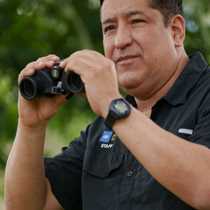Amazon Natural Park & Nauta Caño
This day of exploration of the Peruvian Amazon took us in the morning to a private reserve, the Amazon Natural Park. This protected area is located outside the boundaries of the Pacaya-Samiria Reserve. The owner, a previous Minister of Tourism of Peru, managed this property so well that the Peruvian Government recognized its conservation value declaring it a national private protected area as recently as in June 2011.
There were a few interesting ways to explore this reserve. We started by boarding three catamarans to cross a paradisiacal lagoon by rowing peacefully. After that, we disembarked to go for a hike, a long one or a shorter option. While walking in the forest we admired very big trees, lianas, vines, and wild flowers as well. The trail leads to a very long suspension bridge, which is approximately half-a-mile in length. It allows a thrilling walk in the middle strata of the rain forest just below the upper canopy. At that height we could see the rain forest from a completely different perspective.
After rowing back in the catamarans, just when we were about to board the skiffs to return to the ship, we had a great sighting: a pygmy marmoset (Cebuella pygmaea) was spotted. These small primates have a tawny yellow-gray coloration with fine striations and a pronounced little mane that gives them one of their common names “leoncillo” or translated to English “little lion.” This tiny monkey is the world’s smallest true monkey. It is so small that in fact it could fit inside a shirt pocket, the latter originated another widespread common name, “mono de bolsillo” or “pocket monkey.”
Once aboard, refreshed with a well-deserved shower we had our lunch. In the early afternoon, our photo instructor Walter Perez gave a talk on how to take better pictures. Walter explained some photo tips and gave advice about composition as well.
The rest of the afternoon was spent exploring Nauta Caño. In the morning we were blessed by the weather conditions for we had a relatively beautiful sunny morning that made us forget that we are in one of the wettest ecosystems on Earth. In the afternoon the weather changed drastically for we had a constant misty rain and drizzle that lasted for several hours. Despite the rain we truly enjoyed this outing. This narrow stream locally known in Spanish as “caño” (roughly translated to English as a creek), is covered with thick vegetation where our naturalists spotted several species of colorful birds like macaws, hoatzins, as well as a couple of Squirrel monkey troops and even some Three-toed Sloths.
Finally, late in the afternoon during cocktail hour, the Delfin II naturalists told our guests about their interesting lives and backgrounds. After dinner we had a night walk. The darkness of the night together with thousands of sounds and a soft rain as companions made us realize that we were not dreaming; we were in fact walking in the Amazon at night! We finally came back on board we went to bed with many unforgettable feelings and memories, a little tired but happy from having spent a great full day of exploration of the Peruvian Upper Amazon.




